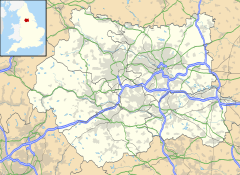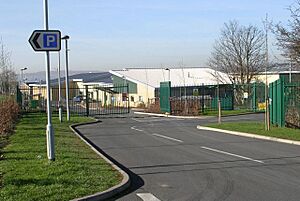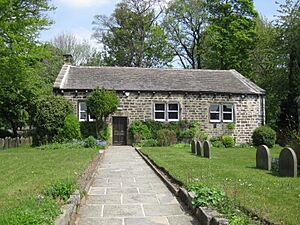Rawdon, West Yorkshire facts for kids
Quick facts for kids Rawdon |
|
|---|---|
 St Peter's Church, Rawdon |
|
| OS grid reference | SE421439 |
| Civil parish |
|
| Metropolitan borough | |
| Metropolitan county | |
| Region | |
| Country | England |
| Sovereign state | United Kingdom |
| Post town | LEEDS |
| Postcode district | LS19 |
| Dialling code | 0113 |
| Police | West Yorkshire |
| Fire | West Yorkshire |
| Ambulance | Yorkshire |
| EU Parliament | Yorkshire and the Humber |
| UK Parliament |
|
Rawdon is a village and a local area with its own council, called a civil parish. It is located in the City of Leeds, in West Yorkshire, England. The village sits near the River Aire and the A65 road, just south of Yeadon.
The northern parts of Rawdon are in the Guiseley and Rawdon area of Leeds City Council. The southern part is in the Horsforth area. The entire village is part of the Leeds North West area for national government elections.
Contents
Exploring Rawdon's Past
The name Rawdon comes from old languages. Rauðr is an Old Norse word meaning "red." Dūn is an Old English word meaning "hill." So, Rawdon means "Red Hill."
Even before the Domesday Book was written in 1086, people lived in Rawdon. Archeologists have found bronze axe heads and a gold torc (a type of necklace). These finds show that people were here as early as the Bronze Age.
In the Domesday Book, Rawdon was mentioned as belonging to the King. There were five landowners, some Norman and some Saxon. The area had lots of pasture land for animals and some land for farming.
Early Settlers and Landowners
Paul (or Paulyn) de Rawdon was a commander of archers. He served William the Conqueror during the Norman conquest. In 1069, he was given land in Rawdon for his bravery. This included a large estate, or manor, on Rawden Hill. He then took the name "Paulyn of Rawden Hill Manor."
His family lived in the area for the next 400 years. They often gave land to religious places like Bolton Priory and Kirkstall Abbey.
Changing Hands: The Layton Family
After religious places lost their land, much of Rawdon went to the King. Over time, the land changed owners many times. Eventually, Francis Layton bought a large part of Rawdon. He also owned land in Yeadon and Horsforth.
Francis Layton supported the King during the English Civil War. Because of this, he was put in prison in 1645 and had to pay a large fine. He lived in the old Rawdon family home, which is now called Layton Hall. The Layton family owned this estate until 1718.
Later, the Emmott family took over the estate. In the 1860s, their agent, Col. Charles Payne Barras, started brick and tile factories. He used the clay found in the area.
Rawdon Hall and Its History
George Rawdon was a descendant of the original Rawdon family. He had a new house built in Cliffe Lane. It was known as Rawdon Low Hall and is now called Rawdon Hall. A stone shows it was finished in 1625.
George Rawdon worked for an important leader in Ireland. He left his son-in-law, John Stanhope II, to manage his estates.
Rawdon was a civil parish from 1866 to 1937. It then joined the Horsforth parish. But on October 15, 2012, Rawdon became its own civil parish again.
Places to See in Rawdon
Rawdon Billing is a well-known hill and landmark. You can see it from far away. It's a popular spot for walks and offers great views of Rawdon from the top.
Little London Village
The village of Little London is in the western part of Rawdon. It has a special area called a conservation area. This means its historic buildings and character are protected. This unique area crosses the border between the cities of Leeds and Bradford.
Before 1974, this area was part of a district called Aireborough. After a local government change, Aireborough was split between Leeds and Bradford. The Leeds part of the conservation area was created in 1975 and made larger in 1988. The Bradford part was created in 1977.
Cragg Wood: A Historic Suburb
Rawdon Cragg Wood is a special area with beautiful Victorian houses. These homes were built in the late 1800s. Wealthy wool and cloth merchants from Leeds and Bradford built them. The houses are set in large, wooded areas.
One person from that time said that new "self-made nobles" (people who became rich through business) built these lovely homes. They made the landscape even more beautiful.
Schools in Rawdon
Rawdon has a long history of education. Many schools have been built here over the years.
Early Schools
Nether Yeadon School was started in 1703. It was a joint effort by Quakers and Baptists. The Layton family provided the land for a very small rent. The school was rebuilt in 1821 and later became a private home called Layton Cottage.
Thomas Layton had St. Peter's Church School built in 1710. It was a school for boys. A separate church school for girls and infants opened in 1861. It was later expanded. The school building burned down in 1951 but was rebuilt and reopened in 1965. Today, it is still active as Rawdon St Peters C of E Primary School.
Woodhouse Grove School was established in 1811 by the Wesleyans. It first opened in 1812 as a school for the sons of Wesleyan ministers. Later, it also welcomed sons of other people.
Other schools in the area included the Friends School (1832-1921) and the Baptist Ministerial Training College (1859-1970s). Little London School, built in 1846, was used as an infants school until 1960. Littlemoor Primary School opened in 1879. It closed in 2005, and the new Rawdon Littlemoor Primary School now uses a different building.
Brontë House School opened in 1934 as a preparatory school for Woodhouse Grove. Its pre-preparatory department, Ashdown Lodge, opened in 1993.
Benton Park School
Benton Park School is the local secondary school. It is located on Harrogate Road. A school for boys was run on these grounds from 1838. The old building was taken down, and a new one opened in 1960. Another new building opened in 2022. The school is sometimes used as a fictional place in the TV show Emmerdale.
Places of Worship
Rawdon is home to several churches and religious meeting places.
St Peter's Church was built by Francis Layton in 1645. It was a chapel for the larger parish of Guiseley. Because of the English Civil War, it took many years to build. It was finally officially opened in 1684. A tower was added in 1707. The church was mostly rebuilt in 1864.
Rawdon also has a Quaker meeting house built in 1697. Trinity Church is a shared church for Baptists, Methodists, and United Reform groups. It is in the building of the former Benton Congregational Church, which opened in 1846.
Famous People from Rawdon
- Brian Close — a famous cricketer
- Hedley Verity — another famous cricketer
- William Thompson — a merchant who was one of the first to import Australian wool in 1808
Location Map
 |
Guiseley | Yeadon | Bramhope |  |
| Esholt | Horsforth | |||
| Apperley Bridge | Calverley | Rodley |





